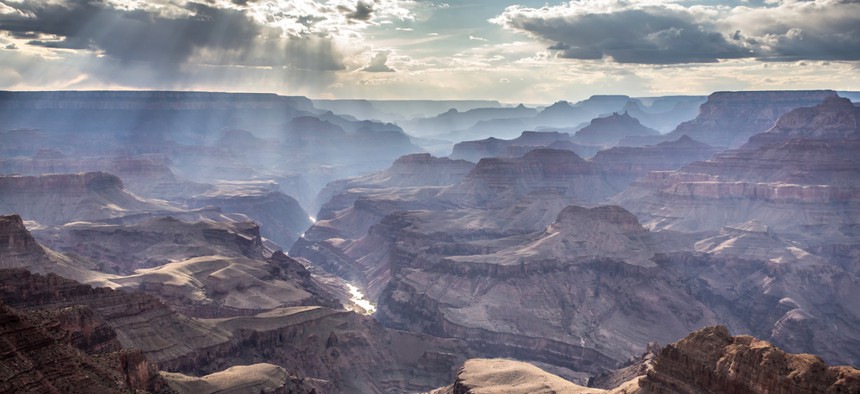
Pierre Leclerc/Shutterstock.com
Park Service Designates Site of a 1950s Plane Crash as a Landmark You Will Never See
Move raises broader questions about the purpose of preservation, and the balance between conceptual and physical efforts to save something.
There was a thunderstorm over the Grand Canyon the morning that two airplanes vanished there the summer of 1956.
Investigators later determined that the TWA and United Airlines flights had collided in mid-air, some 21,000 feet above the canyon, killing all 128 people aboard both aircraft.
At the time, it was the deadliest accident in commercial aviation history, and it prompted a huge push for aviation safety that culminated in the creation of the Federal Aviation Administration. The crash response eventually led to the development of nationwide radar, collision avoidance systems, flight-data recorders, and sophisticated navigation tools.
In other words, much of the infrastructure of modern aviation security can be traced back to June 30, 1956, the day of the Grand Canyon mid-air collision.
Seeing the accident as a turning point is what captured the attention of the National Park Service, which announced last week that the site of the crash is now officially a National Historic Landmark.
The designation is unusual. For one thing, it may be the first landmark to commemorate something that happened exclusively in the air.
"And we've never done an actual crash site," said Alexandra Lord, branch chief of the National Historic Landmarks Program in Washington, D.C. "In some ways we can argue that the crash itself—which led to the scattering of pieces over a huge debris field—is what's crucial. And it sort of doesn't matter if you think of it as on the air or on the ground."
Although people tend to think of National Historic Landmarks as buildings, historians at Park Service try to be fluid in their consideration of potential sites.
Technological crossroads are big, and frequently emerge as contributors to the kinds of broad patterns the Park Service looks for in deciding what to accept as a Landmark site. "We do a fair number that deal with major moments in the history of tech or history of engineering," Lord told me. "It's impossible to say how many."
But those tech-oriented sites are often physical places that were significant over sustained periods of time, like the Detroit factory that revolutionized assembly-line car production or a covered bridge that introduced a new and influential kind of truss. Those sorts of landmarks changed the factories and bridges that came after them, but they were also physical markers in their communities for years.
National Historic Landmarks have to be on—or, at least, above—American soil. (People have suggested National Historic Landmark status for Tranquility Base, where humans first landed on the moon, but Lord says it would fit better as a World Heritage Site.)
This latest designation raises broader questions about the purpose of preservation, and the balance between conceptual and physical efforts to save something. If you can turn a plane crash into a landmark, what other fleeting events—hurricanes, conversations, gunshots, chance meetings, etc.—can we try to save?
The other curious thing about the TWA-United accident site is that the landmark's location is being kept secret.
And much of the information on nomination forms for the site is heavily redacted. We know the planes went down somewhere in the Grand Canyon, "a wasteland" of "jagged mountains, deep canyons and parched desert," according to a 1956 New York Times article about the crash.
But not only is there no expectation that the Park Service is preserving this so people can see it, members of the public are expressly banned from going there.
"It's extremely remote, so it would take a very long time for someone to get there backpacking and it would be very difficult to reach," Lord said. "But we know where it is and we're going to work to preserve it."
The landmark spans 1.5 square miles and has been closed to hikers since the 1950s, though people have reported encountering the wreckage since then.
A year after the crash, one man claimed to have found a TWA spoon, blackened coins, and other artifacts in the area. And although there was an effort to transport human remains from the site, much of the wreckage stayed in the canyon for decades.
Even after an additional clean-up area in the 1970s, much of the evidence of the crash remains where it landed more than half a century ago.
State and federal officials are tasked with preserving the site as it is. But for most of us, the landmark is just a story about an accident that happened in an instant. The site will remain unseen even if it is saved.
(Image via Pierre Leclerc/Shutterstock.com)






